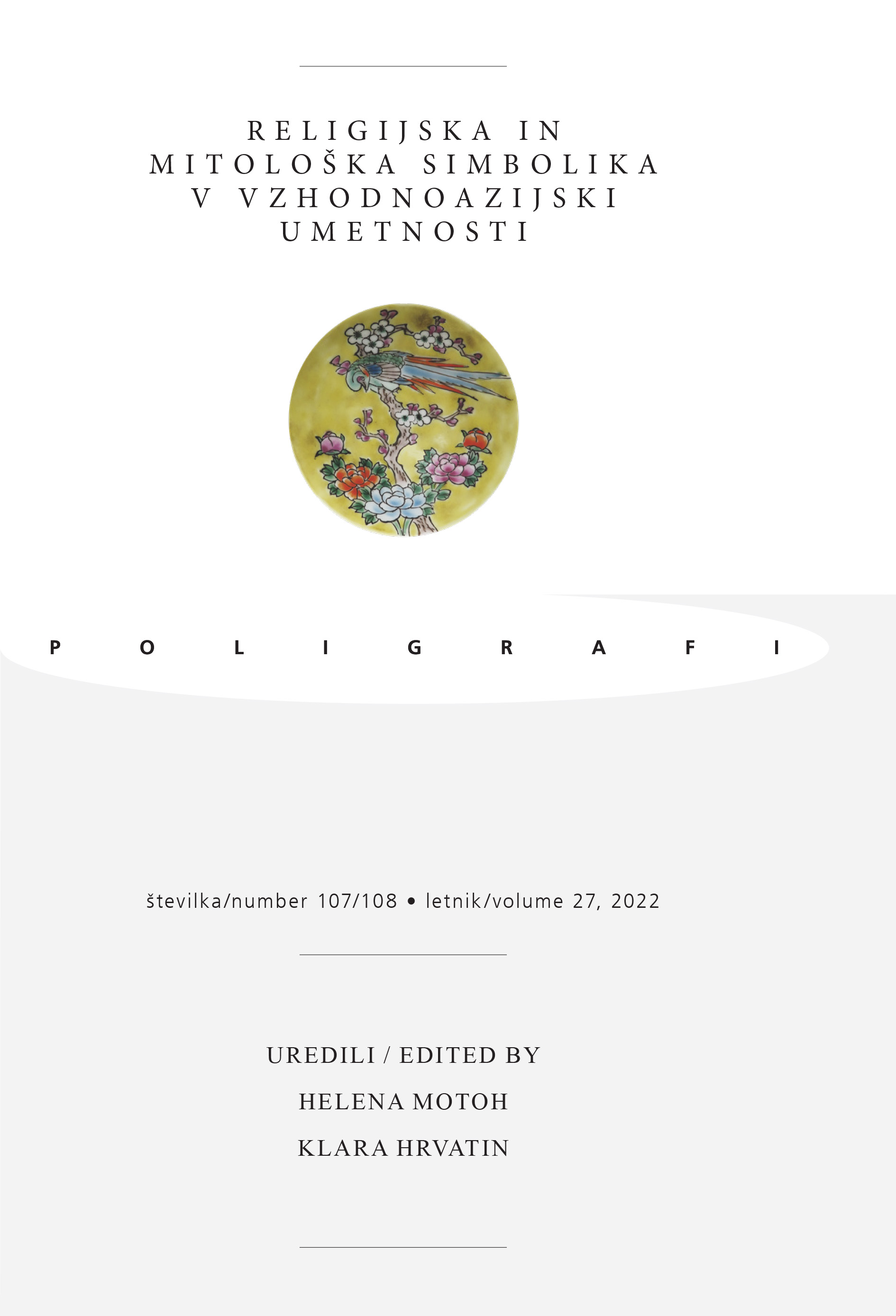Understanding the Motifs and Symbolism in the East Asian Porcelain from the Collection of the National Museum of Slovenia
DOI:
https://doi.org/10.35469/poligrafi.2022.351Keywords:
symbolism and motifs, Chinese porcelain, Japanese porcelain, National Museum of Slovenia, three friends of winter, dragon and phoenix, export porcelainAbstract
The paper presents an analysis of selected motifs which appear in various examples of decorated porcelain from East Asia which is stored in the ceramics collection of the National Museum of Slovenia. Through an analysis of primary sources and secondary literature, as well as through direct handling of the objects, this paper presents the first overview of decorative styles and selected plant and animal motifs most often encountered on porcelain dated to the period between the first half of the 17th century and the end of the 19th century (or the beginning of the 20th century). Relating to the analysis of motifs and symbolism, three case studies of individual objects are presented, the decorative elements of which give an insight into the rich stories connected with the cultural-historical background of trade and cultural exchanges between Europe and East Asia. The paper highlights examples of Chinese and Japanese export porcelain, which were mass-produced products for Western markets, but decorated with East Asian motifs. The paper leads to a reflection on the role of the studied symbolism in the Japanese and Chinese cultural-historical environments as well as the (potential) role of these motifs in the environment where these objects of East Asian origin eventually came to be, i.e., in the area of today’s Slovenia.
References
Berdajs, Tina. »Zbirateljstvo vzhodnoazijske keramike na Slovenskem v 19. stoletju.« Ars & Humanitas 14, št. 2 (2020): 29–43. https://doi.org/10.4312/ars.14.2.29-43.
Bjaaland Welch, Patricia. Chinese Art: A Guide to Motifs and Visual Imagery. Boston: Tuttle Publishing, 2012.
Eberhard, Wolfram. A Dictionary of Chinese Symbols: Hidden Symbols in Chinese Life and Thought. London, New York: Routledge, 1986.
Edmunds, William H. Pointers and Clues to the Subjects of Chinese and Japanese Art: As Shown in Drawings, Prints, Carvings and the Decorations of Porcelain and Lacquer, with Brief Notices of the Related Subjects (Reprint). Chicago, Illinois: Art Media Resources Ltd., 2001.
Encyclopædia Britannica. »fleur-de-lis.« Britannica. Dostop 29. novembra 2022. https://www.britannica.com/topic/fleur-de-lis.
Fournery, Nicolas. »A pair of Chinese famille rose plates from the ‘Serviço dos Pavões’. Qianlong period.« Galerie Nicolas Fournery. Dostop 28. avgusta 2022. https://www.galerienicolasfournery.com/collection/a-pair-of-chinese-famille-rose-plates-from-the-servico-dos-pavoes-qianlong-period/.
Hamano, Sachiko. »Kiku-no-hana (Chrysanthemum).« Nihongo Instructor Club: Japanese language school Azabu Juban Tokyo. Dostop 3. septembra 2022. https://nicjapanese.com/column/kiku/.
Impey, Oliver, J. V. G. Mallet in John Ayers. Porcelain for Palaces: The Fashion for Japan in Europe 1650-1750. London: Oriental Ceramic Society, 1990.
Impey, Oliver. Chinoiserie: The Impact of Oriental Styles on Western Art and Decoration. New York: Charles Schreiber’s Sons, 1977.
Impey, Oliver. Japanese Export Porcelain: Catalogue of the Collection of the Ashmolean Museum, Oxford. Amsterdam: Hotei Publishing, 2003.
Kanazawa, Yoh, He Li in William R. Sargent. »Chapter 10: The Export and Trade of Chinese Ceramics.« V Chinese Ceramics: From the Paleolithic Period through the Qing Dynasty, uredili Li Zhiyan, Virginia L. Bower in He Li, 535–602. New Haven, CT: Yale University in Foreign Language Press, 2010.
Kang, Siliang. »Symbolic Meanings of Chinese Porcelains from the Market Street Chinatown.« Market Street Chinatown Archaeological Project. Dostop 1. decembra 2022. https://marketstreet.stanford.edu/wp-content/uploads/2013/08/Kang-2013.pdf.
Kos, Mateja. »Porcelan in njegova uporaba na Slovenskem / Porcelain and its use in Slovenia.« V Predmet kot reprezentanca – Okus, ugled, moč / Objects as Manifestations of Taste, Prestige and Power, uredila Maja Lozar Štamcar, 145–164. Ljubljana: Narodni muzej Slovenije, 2009.
Lazarini, Franc. Zgodovina rodbine Lazarini: Kronika, dokumenti, genealogija, komentarji, zgodbe. Radovljica: Didakta, 2013.
Madsen, Andrew D. in Carolyn L. White. Chinese Export Porcelain. London in New York: Routledge, 2009.
Nilsson, Jan-Erik. »Double Peacock Service.« Gotheborg. Dostop 10. junija 2021. https://gotheborg.com/glossary/doublepeacock.shtml.
Nilsson, Jan-Erik. »Japanese ‘Imari’ decoration, (Aka-e).« Gotheborg. Dostop 10. junija 2021. https://www.gotheborg.com/glossary/japaneseimari.shtml.
Pierson, Stacey. Designs as Signs: Decoration and Chinese Ceramics. London: School of Oriental and African Studies, University of London in Percival David Foundation, 2001.
Rotondo-McCord, Lisa, in Peter James Buften. Imari: Japanese Porcelain for European Palaces from the Freda and Ralph Lupin Collection. New Orleans, LA: New Orleans Museum of Art, 1997.
Schumacher, M. »Phoenix.« Buddhism & Shintōism in Japan: A-to-Z Photo Dictionary of Japanese Religious Sculpture & Art. Dostop 4. septembra 2022. https://www.onmarkproductions.com/html/ho-oo-phoenix.shtml.
Smith, Lawrence R. H., in Anthony du Boulay. »XV The ‘Quail’ Pattern.« V Porcelain for Palaces: The Fashion for Japan in Europe 1650-1750, uredili Oliver Impey, J. V. G. Mallet in John Ayers, 296–303. London: Oriental Ceramic Society, 1990.
Ströber, Eva. Ming!: Porcelain for a Globalised Trade. Stuttgart: Arnoldsche, 2013.
Suchomel, Filip. 300 Treasures: Chinese Porcelain in the Wallenstein, Schwarzenberg & Lichnowsky family collection. Prague: Academy of Arts, Architecture and Design in Prague, 2015.
Suffolk Wildlife Trust. »Grouse, partridges, pheasant and quail.« Suffolk Wildlife Trust. Dostop 29. november 2022. https://www.suffolkwildlifetrust.org/wildlife-explorer/birds/grouse-partridges-pheasant-and-quail.
Trnovec, Barbara in sod. Azija me je povsem uročila (Asia utterly bewitched me). Celje: Pokrajinski muzej Celje. Ljubljana: Univerza v Ljubljani Filozofska Fakulteta, 2019.
Vampelj Suhadolnik, Nataša. »Zbirateljska kultura in vzhodnoazijske zbirke v Sloveniji.« V Procesi in odnosi v Vzhodni Aziji: zbornik EARL, uredili Andrej Bekeš, Jana S. Rošker in Zlatko Šabič, 93–137. Ljubljana: Znanstvena založba Filozofske fakultete Univerze v Ljubljani, 2019.
van Baarsen, Hans. »Chinese Porcelain: Chinese Imari 1700-1800.« Pater Gratia Oriental Art. Dostop 21. junij 2021. https://www.patergratiaorientalart.com/home/1323.
van Baarsen, Hans. »Chinese Porcelain: Famille Rose wares 1725-1800.« Pater Gratia Oriental Art. Dostop 21. junija 2021. https://www.patergratiaorientalart.com/home/21.
van Baarsen, Hans. »Japanese Porcelain: Japanese Imari 1690-1800.« Pater Gratia Oriental Art. Dostop 10. junija 2021. https://www.patergratiaorientalart.com/home/1690.
Watson, F. J. B., in Gillian Wilson. Mounted Oriental Porcelain in the J. Paul Getty Museum. Santa Monica, CA: Getty Trust Publications, 2000.
Williams, C. S. A. Chinese Symbolism and Art Motifs: A Comprehensive Handbook on Symbolism in Chinese Art Through the Ages, Fourth Revised Edition. Tokyo, Rutland, Vermont, Singapore: Tuttle Publishing, 2006.
Zhiyan, Li. »Chapter 8: Ming Dynasty Ceramics.« V Chinese Ceramics: From the Paleolithic Period through the Qing Dynasty, uredili Li Zhiyan, Virginia L. Bower in He Li, 426–429. New Haven, CT: Yale University in Foreign Language Press, 2010.


